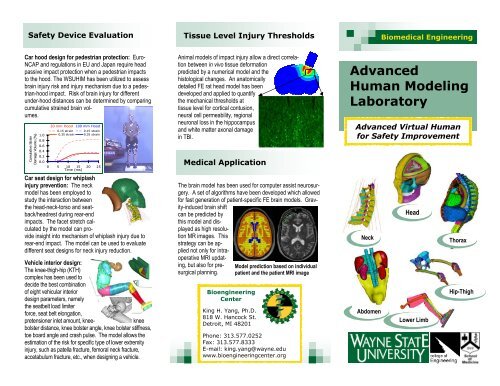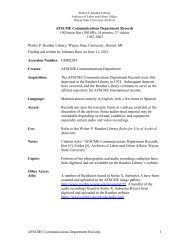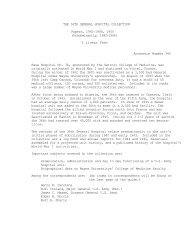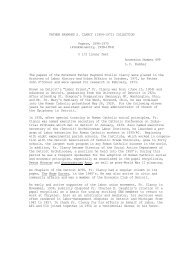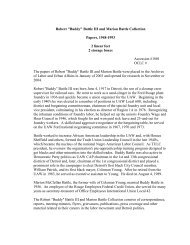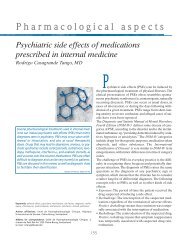Human Modeling Lab - Wayne State University
Human Modeling Lab - Wayne State University
Human Modeling Lab - Wayne State University
Create successful ePaper yourself
Turn your PDF publications into a flip-book with our unique Google optimized e-Paper software.
Safety Device Evaluation<br />
Car hood design for pedestrian protection: Euro-<br />
NCAP and regulations in EU and Japan require head<br />
passive impact protection when a pedestrian impacts<br />
to the hood. The WSUHIM has been utilized to assess<br />
brain injury risk and injury mechanism due to a pedestrian-hood<br />
impact. Risk of brain injury for different<br />
under-hood distances can be determined by comparing<br />
cumulative strained brain volumes.<br />
Cumulative Strain<br />
Damage Volume (%)<br />
1.0<br />
0.8<br />
0.6<br />
0.4<br />
0.2<br />
0.0<br />
20 mm Hood 100 mm Hood<br />
0.15 strain 0.15 strain<br />
0.35 strain 0.35 strain<br />
0 5 10 15 20 25<br />
Time (ms)<br />
Car seat design for whiplash<br />
injury prevention: The neck<br />
model has been employed to<br />
study the interaction between<br />
the head-neck-torso and seatback/headrest<br />
during rear-end<br />
impacts. The facet stretch calculated<br />
by the model can provide<br />
insight into mechanism of whiplash injury due to<br />
rear-end impact. The model can be used to evaluate<br />
different seat designs for neck injury reduction.<br />
Vehicle interior design:<br />
The knee-thigh-hip (KTH)<br />
complex has been used to<br />
decide the best combination<br />
of eight vehicular interior<br />
design parameters, namely<br />
the seatbelt load limiter<br />
force, seat belt elongation,<br />
pretensioner inlet amount, knee- knee<br />
bolster distance, knee bolster angle, knee bolster stiffness,<br />
toe board angle and crash pulse. The model allows the<br />
estimation of the risk for specific type of lower extremity<br />
injury, such as patella fracture, femoral neck fracture,<br />
accetabulum fracture, etc., when designing a vehicle.<br />
Tissue Level Injury Thresholds<br />
Animal models of impact injury allow a direct correlation<br />
between in vivo tissue deformation<br />
predicted by a numerical model and the<br />
histological changes. An anatomically<br />
detailed FE rat head model has been<br />
developed and applied to quantify<br />
the mechanical thresholds at<br />
tissue level for cortical contusion,<br />
neural cell permeability, regional<br />
neuronal loss in the hippocampus<br />
and white matter axonal damage<br />
in TBI.<br />
Medical Application<br />
The brain model has been used for computer assist neurosurgery.<br />
A set of algorithms have been developed which allowed<br />
for fast generation of patient-specific FE brain models. Gravity-induced<br />
brain shift<br />
can be predicted by<br />
this model and displayed<br />
as high resolution<br />
MR images. This<br />
strategy can be applied<br />
not only for intra-<br />
operative MRI updating,<br />
but also for presurgical<br />
planning.<br />
Bioengineering<br />
Center<br />
King H. Yang, Ph.D.<br />
818 W. Hancock St.<br />
Detroit, MI 48201<br />
Model prediction based on individual<br />
patient and the patient MRI image<br />
Phone: 313.577.0252<br />
Fax: 313.577.8333<br />
E-mail: king.yang@wayne.edu<br />
www.bioengineeringcenter.org<br />
Advanced<br />
<strong>Human</strong> <strong>Modeling</strong><br />
<strong>Lab</strong>oratory<br />
Advanced Virtual <strong>Human</strong><br />
for Safety Improvement<br />
Neck<br />
Abdomen<br />
Biomedical Engineering<br />
Head<br />
Lower Limb<br />
Thorax<br />
Hip-Thigh
About<br />
Advanced <strong>Human</strong> <strong>Modeling</strong> <strong>Lab</strong> / Biomedical Engineering — Bioengineering / <strong>Wayne</strong> <strong>State</strong> <strong>University</strong><br />
In 2000, injuries in the United <strong>State</strong>s resulted in<br />
149,000 fatalities with 50 million people required medical<br />
attention. The leading cause of fatal injuries is motor<br />
vehicle crashes. Presently, anthropomorphic test<br />
devices (ATDs) are commonly used to evaluate vehicular<br />
safety systems. Unfortunately, ATDs exhibit significant<br />
deficiencies when predicting real world human<br />
injuries. With the rapid advancement in computing technology,<br />
we envision that human responses in activities<br />
ranging from those of daily living to high-speed motor<br />
vehicle crashes can be simulated quickly with accuracy.<br />
The Advanced <strong>Human</strong> <strong>Modeling</strong> <strong>Lab</strong>oratory of the<br />
Bioengineering Center have developed detailed finite<br />
element models of human body from head to toe since<br />
the early 1990’s. These models have been validated<br />
against existing<br />
cadaveric data at<br />
global and local<br />
levels. The<br />
model has been<br />
used to predict<br />
human responses<br />
in various impact<br />
environments to<br />
further understand<br />
injury mechanisms<br />
and predict the risk of many specific injuries.<br />
WSU <strong>Human</strong> Body Model<br />
The WSU head injury model simulates all essential<br />
anatomical features of the human head and face. The<br />
model consists of a total of over 335,000 elements.<br />
The model has been validated against intracranial pressure,<br />
brain/skull relative displacement and facial impact<br />
test data. The model is well suited for simulating a<br />
range of dynamic loadings causing bony, soft tissue,<br />
vascular and neural injuries.<br />
The WSU neck model simulates all the bony structures, articular<br />
surfaces, relevant ligaments and intervertebral discs.<br />
The model has been validated against quasi-static loading,<br />
near vertex drop and rear impact. The WSU thorax–shoulder<br />
model includes a detailed description of the organs in the<br />
chest, a finely meshed aortic structure and a detailed shoulder.<br />
The model has been validated against frontal and lateral<br />
impact and side airbag deployment tests. The WSU abdomen<br />
model simulates both solid and hollow organs of the human<br />
abdomen. The model has been validated against cadaveric<br />
pendulum impact, drop test and seatbelt loading data. The<br />
WSU lower limb model includes anatomical components<br />
from hip to toe with detailed ankle and knee. The model has<br />
been validated at the segmental and the full limb levels.<br />
Injury Mechanisms<br />
Traumatic brain injury: Traumatic brain injury (TBI) is a leading<br />
cause of death and disability in the United <strong>State</strong>s. Numerical<br />
reconstruction of head impact occurred during the NFL<br />
games provided a unique means to compare simulated brain<br />
responses with physician determined signs and symptoms and<br />
to investigate tissue-level mechanisms for concussive injury.<br />
The results showed that strain and strain-rate responses in<br />
specific regions of the brain and phases of the response correlate<br />
with return to play, cognitive<br />
and memory problems. These<br />
correlations imply that FE models<br />
and strain-related injury criteria<br />
offer new insights into the timing of<br />
concussion injuries and affected<br />
locations. The helmet designed to<br />
reduce strain effect after primary<br />
impact would be an important new<br />
focus for research.<br />
Noninjury Concussion<br />
Striking<br />
Struck<br />
Neck injury in rollover crash: In the United <strong>State</strong>s,<br />
rollover-related fatalities accounted for more than onethird<br />
of all deaths from passenger vehicle<br />
crashes. The neck model has been<br />
used to investigate the injury mechanism<br />
during rollover crashes. Different seat<br />
belt designs as well as the roof interior<br />
designs can be evaluated and optimized<br />
during different rollover scenarios.<br />
Aorta rupture in side impact: Traumatic rupture of<br />
the aorta (TRA) is the second most common cause of<br />
fatality in automotive crashes. The rate of TRA in nearside<br />
crashes is twice that in frontal crashes. The aortic<br />
tears are commonly found in the peri-isthmic region<br />
and nearly transverse to the longitudinal axis of the<br />
aorta. By simulating the real world crash cases with<br />
human model, injury mechanisms of the TRA is elucidated<br />
and local aortic stress and strain patterns is<br />
linked to the clinically<br />
seen rupture.<br />
Shoulder injury in side impact:<br />
Previous studies have hypothesized<br />
that engaging the shoulder<br />
may reduce chest injury in side<br />
impact. The shoulder model has been used to understand<br />
the interaction between the shoulder and the<br />
thorax. During side impact, the shoulder do appear to<br />
uptake some of impact energy, however, the protection<br />
of the acromio-clavicular joint is needed before shoulder<br />
can provide protection to the ribcage.


